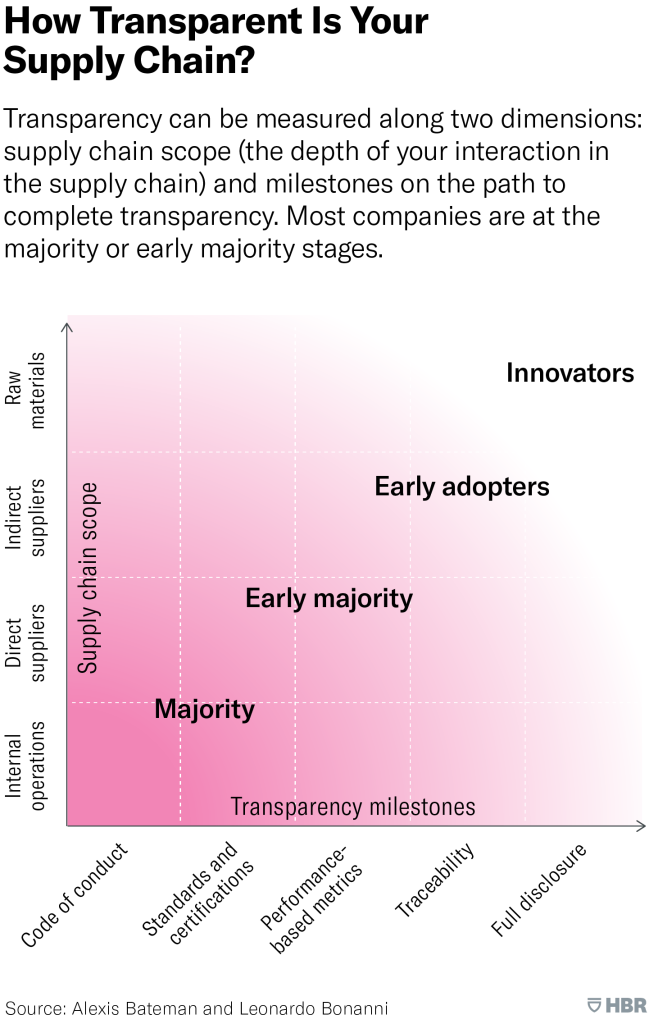
Trust Exercise
Understanding how supply chain transparency builds consumer loyalty
Since March 2020, we’ve been collectively experiencing disruption after disruption of our daily lives. It seems like after having everything halted, both people and businesses have been having a hard time gaining speed again as the world opens back up. With that, supply chain transparency, an area of business that was a growing focus pre-pandemic, has become of paramount importance.
Like many buzzy terms, supply chain transparency is being thrown around often, but what does this concept actually mean in practice? Supply chain transparency requires companies to have oversight of their entire supply chain, and “be fully transparent about how their products are made, what they’re made out of, and how they’re kept safe on the way to store shelves” (Forbes, 2021). In effect, supply chain transparency is both about internal data and how that data is communicated to consumers.
There are many reasons why supply chain transparency has become increasingly important to consumers (and therefore businesses). Pandemic aside, growing concerns around ethical sourcing and sustainability have pressed companies to be upfront about their manufacturing processes. With the pandemic, an increase in demand for certain products (and a decrease in availability of those products and shipping capabilities) has created shortages across the globe. CNNBusiness recently reported on how the shipping crisis is going to affect the holiday season, and have repercussions lasting into 2022.
Another effect of the pandemic is that people are more plugged into the digital landscape, resulting in more time to engage with news and current events online. People are learning more about the world we live in, and how their individual behaviors have an impact on larger-scale issues. Conscious consumerism has undoubtedly increased as a result, with a portion of the population being more mindful about which companies they choose to support.
“Covid-19 poses a threat to humanity, uprooting daily life. It’s not surprising that this ubiquitous disruption has deeply reshaped consumer values. As ethical and environmental consumerism continues to rise, businesses must illuminate sustainable sourcing, transparency and traceability.”
With the shipping delays and product shortages (anyone else still waiting on a couch to arrive?) sure to continue, consumers are wanting answers. What some companies don’t seem to understand is that oftentimes consumers don’t just want products to arrive quickly (and in many cases this is impossible right now), but consumers do want reliable information so that they can set expectations accordingly. Think about it—wouldn’t you be much less frustrated with shipping delays if, at the point of sale, companies were explaining the pain points in their supply chain and setting realistic expectations around when a product is likely to arrive?
In order to communicate this effectively, however, you need reliable information.


Let’s Get Digital!
How to navigate the shifting landscape towards traceability and transparency
Being a digitized brand allows you access to actionable data—that is, data which empowers you to make better decisions for your consumers and business. But what does it mean to be a digitized brand? In an article about defining supply chain transparency, Harvard Business Review noted being a digitized brand was a key differentiator when it came to supply chain volatility. “Digitized brands are armed with analytics, helping them to better understand consumers, align their product lines and educate their suppliers with these findings to customize and tailor experiences.” Digitized brands offer supply chain transparency by gathering information from both suppliers and consumers, and sharing it in each direction. The consumers’ needs better informs the suppliers’ work, and the suppliers’ work better informs the consumers on the products they’re buying.
“In Q1 2021, we conducted a survey of over 700 brands and retailers and found that mass digitization is a plus, as companies with a low degree of supply chain digitization were found to be twice as likely to have serious issues… But still, less than half (44%) of businesses reported having a highly digitized supply chain, and up to 85% admitted to blind spots within their supply chains. So, of the many business lessons learned in the past year, supplier agility echoes loud and clear. Digitization determines supply-demand triumph — or disaster.”
Having access to data across your supply chain not only allows you better insight into your inventory and leaves you better prepared for fluctuating demand, it also allows you to highlight the spots where you are succeeding to your consumers. A company who does this very well is “the apparel company Patagonia. Its Footprint Chronicles map a subset of raw materials, mills, and factories that make Patagonia products and drills down into details about vendors’ operations and staff” (Harvard Business Review, 2021).
As outlined in an article by Forbes, and paraphrased in this article, there are many steps you can take to increasing your supply chain transparency, but the first starts with truly knowing your supply chain end-to-end, and implementing digital solutions to help you do so.

How to increase supply Chain Transparency
(According to Forbes)
Understand where you are now. Take a good look at each step in your supply chain. Where do your materials come from? Where are your products assembled? Where do they ship from?
Know what your consumers care about. Analyze market studies, competition studies, behavior on online platforms, keyword research, and your customer support logs to find out what questions consumers are asking so you can answer them.
Look for easy wins. Are there initiatives you’ve already made headway on? Start with aspects of your business that are easiest to show and build from there.
Get information out in the right way. Different audiences consume information differently, so you’ll want to know how best to disseminate your message to consumers. From ad campaigns to social media posts to on-pack engagement options and more, there are lots of ways to get information to your consumers.
Look for opportunities to improve. Touting that your company has always been environmentally friendly is great, but so is saying you’re in the midst of making positive changes right now. Look for areas where you can improve, and then announce it to the world. It’s never too late to start doing the right thing.
Build a strategy to improve transparency. With all of the data above in hand, create a company-wide strategy that combines the information people care about, the best parts of your process, and the right dissemination strategy for that information.
Track your progress. With technological advancements in tracking, it’s easier than ever to take control of your end-to-end processes and take the first step toward increasing transparency to consumers. Use this information to your advantage to showcase the best parts of your business, and you’ll build trust and loyalty in your consumer base, leading to more sales and a better bottom line.

Leap of (Good) Faith
How an investment in transparency now will pan out later
Doing the right thing is never a bad idea, but it really makes it easier to do the right thing when there’s an additional business incentive for doing so. “For instance, researchers at the MIT Sloan School of Management found that consumers may be willing to pay 2% to 10% more for products from companies that provide greater supply chain transparency” (Harvard Business Review, 2021). The number of conscious and intentional consumers who are looking for transparent and ethical companies is growing. “Across industries, this growing segment of discerning consumers seeks information on product ingredients and materials, where products come from, and the conditions in which they were produced” (HBR). Implementing the technology to trace your materials, and gather the data on progress, takes time. Every day you push off investing in a fully traceable supply chain, is another day you push off utilizing an incredibly powerful marketing tool.
Because supply chain transparency works in both directions, with necessity for the sharing of data between both brand and consumer, and brand and supplier, you need technology that will also work in both directions. Vi3’s suite of tools offers you just this. V Source is your supply chain intelligence source—granting you access to all of your products’ information, in real time. Equipped with the knowledge of what’s in your products, and where they are in their manufacturing cycle, you’ll be able to share sourcing information with your consumers, and set realistic expectations around when they’ll receive their order. V Connect allows you to collect intelligent consumer data, which can better inform the information you share with suppliers.
Not sure where to start in your journey towards traceability and transparency? Our team of expert advisors is ready to discuss a personalized approach with you. Reach out today.